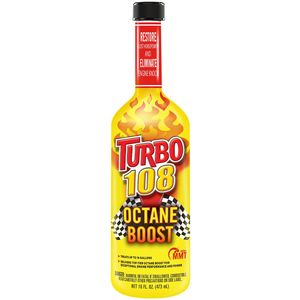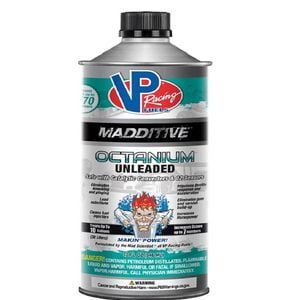You are using an out of date browser. It may not display this or other websites correctly.
You should upgrade or use an alternative browser.
You should upgrade or use an alternative browser.
Question about Turbo fuel
- Thread starter wlong01
- Start date
- :
- 2021 CX-9 Sig
- :
- 2021 CX-5 GT
If the turbo running on 87 octane puts out about 220hp and the turbo running on 93 octane put out a little over 250hp how much does it produce running on 89 octane?
Sounds like a word problem.
This was asked previously and if you assume a linear relationship, it is about 227 with 87 octane, so a difference of 23hp or 3.83 hp per octane rating. Again, assuming a linear relationship, that should give about 235 HP with 89 octane.
Upvote
0
- :
- 2019 CX-5 Signature Soul Red Crystal
My Costco only has 92 octane, does that mean 250hp is unavailable to me?
Upvote
0
What state are you in? Some states require 93 octane be sold, others don't. So it may be harder to find. See this list: https://en.wikipedia.org/wiki/List_of_U.S._states_by_standard_octane_ratingsMy Costco only has 92 octane, does that mean 250hp is unavailable to me?
Mark
Upvote
0
- :
- 2019 CX-5 Signature Soul Red Crystal
That makes sense.This was asked previously and if you assume a linear relationship, it is about 227 with 87 octane, so a difference of 23hp or 3.83 hp per octane rating. Again, assuming a linear relationship, that should give about 235 HP with 89 octane.
Upvote
0
- :
- 2019 CX-5 GTR
My Costco only has 92 octane, does that mean 250hp is unavailable to me?
You can fill up with 92 octane.. then use an octane booster product to get your 250HP
Turbo 108 Octane Boost 16oz
Shop for Turbo 108 Octane Boost 16oz with confidence at AutoZone.com. Parts are just part of what we do. Get yours online today and pick up in store.
VP Racing Fuels Madditive Octanium Unleaded Octane Booster 32oz
Shop for VP Racing Fuels Madditive Octanium Unleaded Octane Booster 32oz with confidence at AutoZone.com. Parts are just part of what we do. Get yours online today and pick up in store.
I've heard / read on the internet it will take ~2 to 3 full tank of fuel at the higher octane for the computer / fuel system to relearn and perform at top performance.
Upvote
0
- :
- 2019 CX-5 Signature Soul Red Crystal
If 92 gets me to 246hp, why do I care about getting that final 4?You can fill up with 92 octane.. then use an octane booster product to get your 250HP

Turbo 108 Octane Boost 16oz
Shop for Turbo 108 Octane Boost 16oz with confidence at AutoZone.com. Parts are just part of what we do. Get yours online today and pick up in store.www.autozone.com

VP Racing Fuels Madditive Octanium Unleaded Octane Booster 32oz
Shop for VP Racing Fuels Madditive Octanium Unleaded Octane Booster 32oz with confidence at AutoZone.com. Parts are just part of what we do. Get yours online today and pick up in store.www.autozone.com
Upvote
0
- :
- 2019 CX-5 GTR
Upvote
0
- :
- 2019 CX-5 Signature Soul Red Crystal
We do CX-5 street racing where I live.I'm amazed at how much time, apparently, people drive these CUV's above 4k RPM.
Upvote
0
If 87 gets you 227 why do you care about the final 23?If 92 gets me to 246hp, why do I care about getting that final 4?
Upvote
0
You didn't mention where you live. If you live at altitude (say, Denver) then the available octanes are lower because the thinner air means the engine is running more rich, so less prone to detonation, and therefore lower octane fuel can be run. I believe this is true of the turbos as well (boost is relative to atmospheric pressure).If 92 gets me to 246hp, why do I care about getting that final 4?
I'm not totally sure how the ECU knows that you are running high octane, as there is no way to chemically measure it. I think the ECU senses detonation, and retards timing to prevent it. So it's not actually the physical properties of the gasoline that is being measured, just the effects on engine performance. That would suggest that the effects of a high octane or low octane fill-up should be immediate, as the engine performance is continuously balanced to prevent detonation.
Upvote
0
I don't think we know whether the CX5 engine runs at the razor edge of engine knock all the time and thus can take advantage of whatever incremental octane you feed it. Personally, I doubt it. Having an engine always on the edge of knock is tricky and may have long-term reliability consequences. What I think is more likely is that the engine runs in a fixed state of tune most of the time with adequate knock/detonation margins even on lower-octane gas and only the most difficult conditions cause knock and the derating. Mazda (to their credit) specs these worst case conditions and the derating that might occur (but doesn't always occur).
I'd love to see some testing done on the same dyno under the same conditions where octane is the only variable. C&D did some testing a while back on a variety of cars and the data was all over the map.
Not that important, but I don't think high-altitude locales have lower octane gas because the engine runs richer - the car's ECU's and throttle bodies can compensate for altitude quite handily to maintain the same A/F ratio. Instead, what is occurring is that the lower atmospheric pressure naturally derates the engine - at full throttle, a CX5 in Leadville CO at 10K feet altitude makes about 30% less power than at sea level. Essentially, engines at high altitude are constantly at part-throttle compared to sea level. And an engine at part-throttle has much less chance of engine knock occurring so there is less octane demand. (Now all this is out the window if the CX5 has an altitude-compensating turbo controller with a variable wastegate that increases boost with altitude, but I believe almost all current turbo cars use a much-cheaper fixed wastegate that maintains a constant maximum boost over sea level power as you climb - thus power drops off with altitude just like a NA car.)
- Mark
I'd love to see some testing done on the same dyno under the same conditions where octane is the only variable. C&D did some testing a while back on a variety of cars and the data was all over the map.
Not that important, but I don't think high-altitude locales have lower octane gas because the engine runs richer - the car's ECU's and throttle bodies can compensate for altitude quite handily to maintain the same A/F ratio. Instead, what is occurring is that the lower atmospheric pressure naturally derates the engine - at full throttle, a CX5 in Leadville CO at 10K feet altitude makes about 30% less power than at sea level. Essentially, engines at high altitude are constantly at part-throttle compared to sea level. And an engine at part-throttle has much less chance of engine knock occurring so there is less octane demand. (Now all this is out the window if the CX5 has an altitude-compensating turbo controller with a variable wastegate that increases boost with altitude, but I believe almost all current turbo cars use a much-cheaper fixed wastegate that maintains a constant maximum boost over sea level power as you climb - thus power drops off with altitude just like a NA car.)
- Mark
Last edited:
Upvote
0
- :
- Occupied Calif.
- :
- 2019 CX 5 GT-R
I live at 6000 ft elevation. There are only three gas stations in town. The convenience store only sells diesel and 87 octane. The Shell and Arco stations sell 87, 89 and 91 octanes, Same as the stations all over California.
I believe that the available octanes and ethanol mix are state mandated according to their particular EPA departments.
I have only run 91 octane in my 2019 GT-R with turbo. I try to give it an Italian Tune Up when I can without driving off a cliff.
I believe that the available octanes and ethanol mix are state mandated according to their particular EPA departments.
I have only run 91 octane in my 2019 GT-R with turbo. I try to give it an Italian Tune Up when I can without driving off a cliff.
Upvote
0
- :
- RDX Aspec Adv.
I asked this a lot when I first got mine. I timed a lot of 20-80mph runs, and came to the conclusion that it is linear. I have run 87, 91, and 93. I clocked my CX5 as linearly faster using these, by very very small margins that equate to the hp one would expect. Of course it's a car, and I used my phone to video and t hen look at the milliseconds of timestamp. That is very imprecise, but it DID show what one expects from linear between 227 and 250.
So now let's look at "common sense"...
The car does not see the pump and say "Oh, bruh, he selected 93!". The gas t ank nor fuel system do not have a build-in lab to calculate that, either.
What I strongly suspect happens, is that Mazda has a very VERY robust pre-detonation detection system within the SA engine's programming. Mazda has a TON of data they monitor on these. It is NOT your old mid 90's port injection cam-in-block motor. I suspect that the timing and cam phasing or whatever else is constantly being adjusted. As such, as soon as ANY little bit of pre-detonation is detected, the software backs off. So within a certain parameter (say, "X degrees timing advance, valve event"), it is constantly adjusting for more top-end power (down low it doesn't really matter). So no, you can't run 100 octane and get 280hp, as 250hp is "the ceiling", likely, with all adjustments "wide open" and detonation not being a factor, but you may technically get 247.781 bhp if your 93 octane is watered down a bit by some 91 in your tank still, or whatever, as the engine is infinitely variably controlled between 227-250bhp output possibilities, to take advantage of the most you're giving it.
So now let's look at "common sense"...
The car does not see the pump and say "Oh, bruh, he selected 93!". The gas t ank nor fuel system do not have a build-in lab to calculate that, either.
What I strongly suspect happens, is that Mazda has a very VERY robust pre-detonation detection system within the SA engine's programming. Mazda has a TON of data they monitor on these. It is NOT your old mid 90's port injection cam-in-block motor. I suspect that the timing and cam phasing or whatever else is constantly being adjusted. As such, as soon as ANY little bit of pre-detonation is detected, the software backs off. So within a certain parameter (say, "X degrees timing advance, valve event"), it is constantly adjusting for more top-end power (down low it doesn't really matter). So no, you can't run 100 octane and get 280hp, as 250hp is "the ceiling", likely, with all adjustments "wide open" and detonation not being a factor, but you may technically get 247.781 bhp if your 93 octane is watered down a bit by some 91 in your tank still, or whatever, as the engine is infinitely variably controlled between 227-250bhp output possibilities, to take advantage of the most you're giving it.
Upvote
1
Similar threads
- Replies
- 58
- Views
- 7K
